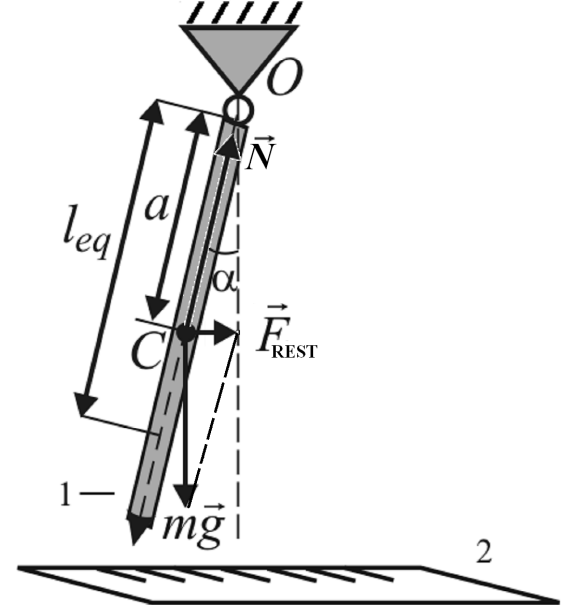
- •Odessa national academy of telecommunications after a. S. Popov
- •Module structure Module № 2. „ Electromagnetic oscillations and waves” – 72 hours total.
- •List of laboratory works
- •Introduction
- •Work 4-1 exploring of harmonic oscillations
- •1 Goal of the work:
- •2 Main concepts
- •2.1 Harmonic oscillations of physical pendulum
- •3 Description of laboratory research facilityand methodology of measurements
- •4 Data processing
- •5 Work execution order and experimental data analysis
- •6 Control questions
- •7 Content of the report
- •6) Table of measurements
- •3 Description of laboratory research facility and methodology of measurements
- •5 Work execution order and experimental data analysis
- •6 Control questions
- •7 Content of the report
- •6) Table of measurements
- •3 Description of laboratory research facility and methodology of measurements
- •5 Work execution order and experimental data analysis
- •6 Control questions
- •7 Content of the report
- •6) Table of measurements
- •7) Quantities calculation:
- •2.2 Parametric resonance. Standing waves.
- •3 Description of laboratory research facility and methodology of measurements
- •5 Work execution order and experimental data analysis
- •6 Control questions
- •7 Content of the report
- •Physics
2.1 Harmonic oscillations of physical pendulum
Figure 1 –
Restoring force
of physical pendulum

FREST = – kqex, (9)
where x – displacement from equilibrium position; kqe – quasi-elastic coefficient.
Negative sign on the right hand side of the equation (9) means that the restoring force always acts in the opposite direction of the displacement. The role of restoring force is fulfilled usually by the total of gravity force and supporting or spring force.
Natural system is an ideal physical model of system with no any energy losses. In the real-world systems there are always act different kind of damping forces, which increase period and decrease amplitude of oscillations (see Laboratory work № 4-3). Regime of oscillations without of losing energy is termed eigenmodes and frequency of such oscillations – eigenfrequency. Parameters of eigenmodes of oscillations are being identified by 0 index.
Let’s consider natural mechanical oscillations of physical pendulum (Fig.1). Physical pendulum is a rigid body suspended from a fixed point in it, free to pivot about some horizontal axis through that point under the force of gravity.
The oscillations description method is in building and solving of differential equations for appropriate motions. If the pendulum shifted from its equilibrium position then there will appear a moment of restoring force (Fig.1):
M = FRESTa = –mgasinα, (10)
here m – mass of a pendulum, a – distance from the pivot point to center of gravity C of the pendulum, α – small enough angle of deflection from equilibrium.
The moment equation gives:
M = Jε, (11)
here
![]() – angular acceleration, so
– angular acceleration, so
mga sinα = Jε,
where J – moment of inertia of the physical pendulum.
Moment of inertiaJ is a physicalanalog of the massof a rotating rigid body. For example, moment of inertia of the rotatingpoint mass m apart on distancel from an axis is
J=ml2. (12)
Then SI measurement units for moment of inertia is kilogram-square meter – [kgm2]. We note that such oscillating point massmon weightless suspension of lengthl is being termed assimple (mathematic) pendulum.
As α is small we can replace sinα by α in moment equation(10):
![]() ,
,
from here we obtain differential equation of oscillations of physical pendulum:
![]() or
or
![]() (13)
(13)
Thus, oscillatory motion of physical pendulum is being described by the homogeneous second order differential equation.
General solution for this differential equation will be equation of oscillations of physical pendulum:
α = αm cos(ω0t+φ0) (14)
Coefficient near α in (12) is squared cyclic eigenfrequency ω0, then
![]() .
(15)
.
(15)
Taking in to account (8) we’ll have a eigenperiod of the physical pendulum
![]() (16)
(16)
In special
case (12), for simple (mathematic) pendulum
![]() and the eigenperiod
will be
and the eigenperiod
will be
![]() .
(17)
.
(17)
Comparison of (16) and (17) shows that it is possible to pick such simple (mathematic) pendulum with length
![]() ,
(18)
,
(18)
which will have same period as a given physical has. Such length leq is called equivalent length of physical pendulum.
Moment of inertia of physical pendulum we can determine using formula (14):
![]() .
(19)
.
(19)
